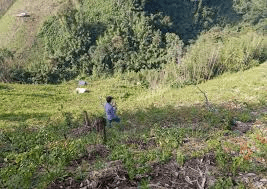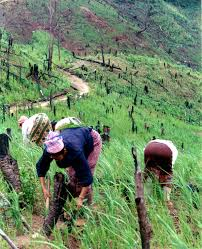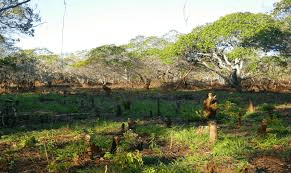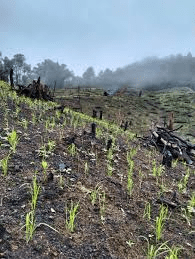Shifting Cultivation is a system of farming that involves the farming of a piece of land by a farmer for a short period of time like 1 – 3 years thereafter leaving the piece of land to fallow for a long period of time say from 5 years, during which time the nutrients will naturally return to the soil.
The period of which the farmers leave the land to fallow vary from place to place and the type of vegetation that grows on the land, amongst other factors. Most importantly, the land is left for the period sufficient for it to regain its lost nutrients.
The process of carrying out Shifting Cultivation varies from one region to another and on the type of vegetation that is available on the land. However, the process or methods adopted by different farmers are not mutually exclusive of one another. Some of the methods are examined in this article.
The Process / Procedure of Carrying Out Shifting Cultivation

The Report on Crop Husbandry and Idodo Umeh (2015) described the process of carrying out Shifting Cultivation. The process was stated to involve a number of stages which are;
Each year the farmers or villagers designate an area of land for planting. This would be the area where they would leave for haven abandoned a previously nutrient exhausted land.
The farmers would then remove the dense vegetation that typically covers the land. The type of farm tools to use is subject to the kind of vegetation on the land. Cutlass and hoe are used when the vegetation is not thick while axe and digger is used where the land is composed of sparse vegetation.
Plants that have economic use are spared while those that have economic use are spared.
Read Also : Basic Features and Characteristics of Shifting Cultivation
At this stage, the debris that is cut down are then burnt with fire. The burning is carried out under carefully controlled conditions to avoid fire spread to areas outside the marked area.
After the burning, ashes are produced and washed down by rains into the soil to produce the needed nutrients.
The cleared area is then planted with crops which can be supported for a period of three (3) years or less, depending on when declining productivity is noticed.
The villagers of farmers then leave the previously cultivated land uncropped/uncultivated for a long period or many years, usually longer than the period the land was cropped/cultivated.

The villagers will return to the deserted or previously cultivated land after a period of about six (6) years or more to begin clearing the land again.
In the meantime, the villagers or farmers may still care for fruit-bearing trees on the site (remember that those trees were not cut down at the initial time).
In another development, Ecological Problems on shifting Cultivation stressed the sequence could still be followed in the manner detailed below;
Selecting a forest patch and clear fell the vegetation normally in December and January
Burning of the vegetation. Small, cut-trunks portion and roots are normally not removed.
The herbs, shrubs and twigs and branches (slashed vegetation) are burnt in February and March
Sowing of seeds, by dibbling, generally of cereals, vegetables and oil seeds in April–May
Continuing cultivation for a few years
Abandoning the cultivated site and shifting to other forest sites
Returning to the former site, and once again practice shifting cultivation on it.
In making the process more concise and in summary, Ecological Problems on shifting Cultivation stated that six (6) major steps have been found in the practice of Shifting Cultivation. The steps are;

The first step: The selection of fields where the farmer would want to farm his/her crops on. As much as possible the land should be a promising location that has the potentials of having good amount of nutrients and growing the farmers desired crops.
The second step: The second step is the clearing of the fields. The clearing involves the removal of the bush and this is carried out with majorly, simple farm tools. Cutlass is used to clear the shrubs and grasses, while axe and digger is used to remove heavy trees and the likes.
In the process of clearing, trees that are of economic value are retained or left untouched.
Read Also : Challenges and Strategies for Enhancing Crop Processing
Burning of the debris: The third stage involves the set of fire on the cleared bush. Efforts are made to ensure that the fire is controlled so that it does not go out of control. Burning actually takes place in the dry season or when the debris is dried up.
The major advantage which burning provides is that ash is provided from the process and it is washed into the soil and thus provides nutrients for the plant.
Burning may be harmful at this stage because it kills the micro and macro organisms in the soil that support nutrient provision and replenishment.
Sowing in the field: The fourth stage is that stage at which planting of seeds and or seedlings are done. The seeds are usually of different crops because Shifting Cultivation supports mixed cropping farming.
Weeding: Weeding of the farm is carried out to allow crops to grow well.
Harvesting: The sixth and last stage is a stage that has to do with the removal of the mature products from the farm.
From this stage, the process repeats itself until productivity begins to drop, that is after about 3 years; and then there might now be need for the farmer to shift from this farm to another location
In summary, the process or procedure of Shifting Cultivation revealed that different authorities have showed the different procedures of Shifting Cultivation. It is clear that the advances of the different authorities are not mutually exclusive of one another.
However, the procedures revealed six major steps in the process of Shifting Cultivation. The steps are selection of fields, clearing of the field, burning of the debris, sowing of crops, weeding and harvesting of the crops.
Shifting Cultivation is a farming system that involves the movement of farmer from one field to another after sowing for a short time and reduction in yield is beginning to be observed. The procedure involves six different stages.
Read Also : How to Generate Money from Agricultural Wastes

